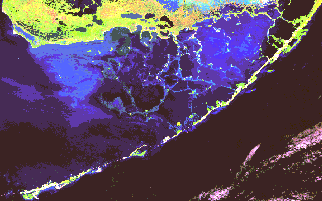You are here: Home › Stressors › Land Use Impacts › Current Programs › South Florida
South Florida Ecosystems
For more detailed information about this program click here.
A Recent Synopsis
Florida Bay:Signs of Ecosystem Stress
P.Glibert, C.Heil, C.Madden, D.Rudnick, J.Boyer and S.Seitzinger
Issue

The impacts of population shifts to U.S. coastal regions, including habitat modification, nutrient and toxic chemical inputs, and fresh water diversions are poorly understood. Examining the combined interactions of natural and human-induced stressors, (e.g., harmful algal blooms (HABs), nutrients or toxics loadings, and habitat loss) is a new approach to studies of coastal degradation that have traditionally focused on individual factors. Better understanding of these cumulative effects and development of integrative approaches to manage these effects is needed for use and protection of coastal resources. NCCOS' Center for Sponsored Coastal Ocean Research (CSCOR) is participating in an extensive federal-state effort to address these needs and restore the south Florida ecosystem. CSCOR is quantifying and modeling existing conditions and ecological relationships along the south Florida coast (including Biscayne Bay, Florida Bay, Florida Keys, and west Florida).
Approach
The Interagency Florida Bay Science Program seeks to develop an understanding of the structure and function of coastal south Florida in the context of its restoration. The program seeks to restore coastal south Florida which includes the re-establishment and maintenance of the natural diversity, abundance and behavior of the marine and estuarine flora and fauna. A major factor controlling these parameters appears to be freshwater and nutrient inputs; however, the proposed additional flow of fresh water through the Everglades may not be sufficient. Timing, location, type and quality of input are all critical parameters, and are, in part, dependent upon land-based restoration activities. Achieving a predictive capability of the physics and ecology of coastal south Florida will allow for testing management strategies, which is the ultimate goal of the CSCOR research.
CSCOR ’s south Florida research activities include empirical studies, development and testing of models, assessing risks, and evaluation of ecological responses of the south Florida coastal marine ecosystem. These activities are grouped into the following topical areas: nutrient inputs and dynamics; water quality; circulation and physical oceanography; fisheries and protected resources; and Florida Keys habitat characterization and research. The program is focused on designing individual ecosystem component models to characterize physical, chemical and biological stressors, and to develop and validate new indicators of stress for key organisms and ecological processes.
The Florida Bay studies, designed to compliment other Federal and state activities underway, will provide decision-makers with the tools to examine the risks to ecological resources of Florida Bay. This program also includes Community Education & Outreach activities that connect research and ecosystem management with the diverse public audiences and interests.
Management and Policy Implications
The impacts on coastal Florida of land-based restoration activities in the Everglades are direct but may not be immediate. The main goal of CSCOR ’s research activities is to achieve a predictive capability to better manage South Florida marine resources and to assist in restoration planning. Attaining a predictive capability allows for a better understanding of the physics and ecology of south Florida coastal ecosystem and its relationship to surrounding marine, terrestrial and atmospheric systems with which it is intimately connected.
Over the past several years, there has been a decline in the abundance of live coral in the Florida Keys National Marine Sanctuary (FKNMS), and shifting patterns of relative abundance of seagrass species in Florida Bay. Management issues concerning hardbottom communities could not be addressed because of a lack of ecological research. Current COP research intends to determine the causes of coral decline with emphasis on cause and effect; possible associations between water quality and seagrass distribution; and the functional significance of hardbottom communities in the FKNMS ecosystem. The fully protected zones of the FKNMS, including the Tortugas Ecological Reserve, were created to assist in the protection of biological diversity and to disperse resource utilization in order to reduce user conflicts and to lessen the concentrated impact to marine organisms on heavily used reefs. Research will soon be underway to monitor commercially important species (e.g., spiny lobster) and key depleted fishery species (e.g., queen conch), as well as to create ecosystem models of reef fish communities to predict the effects of zoning on species diversity, abundance, and trophic structure.
Accomplishments
Researchers have developed a series of initial conceptual models and computer simulation models that quantify and characterize existing conditions and ecological relationships along the south Florida coast, including Biscayne Bay, Florida Bay, Florida Keys, and west Florida. These include: Biscayne Bay hydrodynamic operational simulation model; community-level models of major seagrass community structure and function; population-level model of sponge components of the hardbottom community; landscape level mangrove model for Biscayne Bay; trophodynamic models of the major fish and invertebrate species of the Biscayne Bay-coral reef coupled ecosystem; conceptual model of the societal components, drivers, and stressors of the South Florida regional environment; and a Florida Keys coral reef tract conceptual model.
Other research activities in Florida Bay have resulted in models and tools valuable to the restoration process and to resource managers in the region. This includes data and models of Florida Bay oceanographic and atmospheric conditions that estimate and predict oceanic flow into the Bay, south Florida rainfall amounts and distribution, freshwater Everglades flow into the Bay through the Shark River Slough, mercury accumulation, nutrient cycling, and consequent impacts on Bay living resources. These results are helping researchers and resource managers assess how anthropogenic and long-term natural fluctuations contribute to the current ecological problems in Florida Bay.
Related Links
For more information, contact:
NOAA/NOS/NCCOS/CSCOR
Larry Pugh
phone: 301-713-3338
e-mail: coastalocean@noaa.gov

